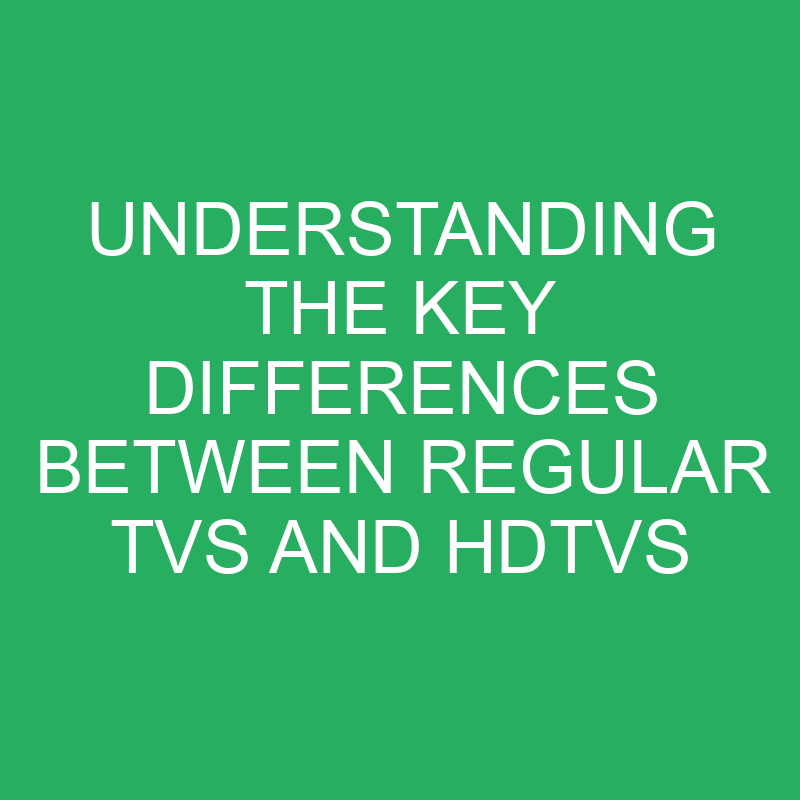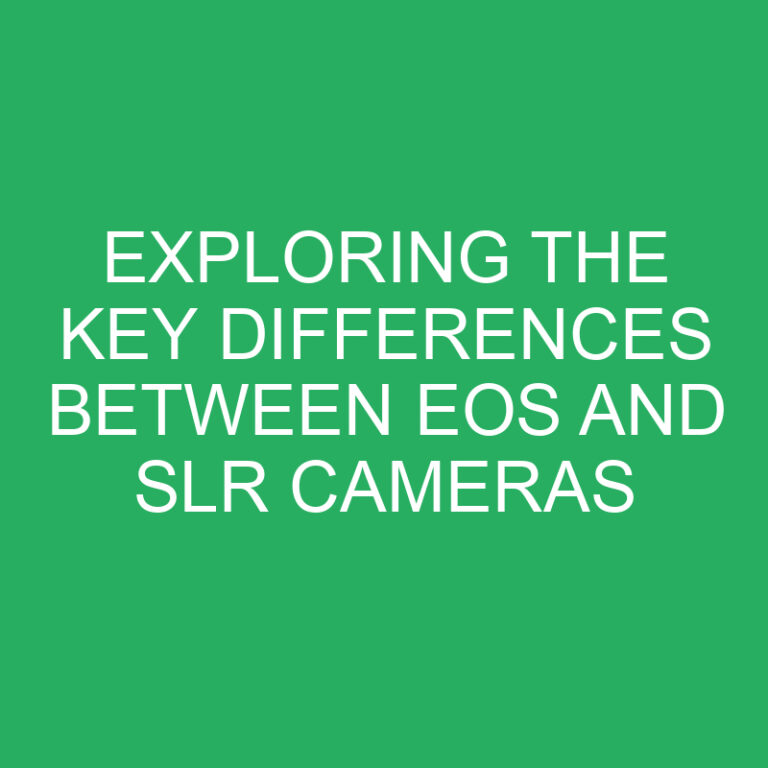
When it comes to choosing the right television for your entertainment needs, the options can be overwhelming. With so many different types of TVs available on the market, it’s important to understand the key differences between them. In this article, I’ll be diving into the distinction between a regular TV and an HDTV, so you can make an informed decision before making a purchase.
Let’s start with the basics. A regular TV, also known as a standard-definition television (SDTV), offers a resolution of 480i. This means that the screen is made up of 480 horizontal lines, and the “i” stands for interlaced, which refers to the way the lines are displayed. On the other hand, an HDTV, or high-definition television, provides a much higher resolution of either 720p or 1080p. The “p” stands for progressive, indicating that the lines are displayed sequentially, resulting in a smoother and more detailed picture.
Now that we’ve covered the resolution, it’s important to note that HDTVs also offer a wider aspect ratio, typically 16:9, compared to the 4:3 aspect ratio of regular TVs. This means that HDTVs are better suited for displaying widescreen content, such as movies and sports, without any cropping or distortion. Additionally, HDTVs often come equipped with advanced features like HDMI ports, which allow for seamless connectivity with other devices like Blu-ray players and gaming consoles.
The main difference between a regular TV and an HDTV lies in the resolution and aspect ratio. While a regular TV offers a lower resolution and a narrower aspect ratio, an HDTV provides a higher resolution and a wider aspect ratio, resulting in a more immersive and visually stunning viewing experience. So, if you’re looking for crystal-clear picture quality and a wider range of content options, investing in an HDTV is definitely worth considering.
Post Contents
Regular TV vs HDTV: Understanding the Differences
When it comes to TVs, there are a few key differences between a regular TV and an HDTV that you should be aware of. These differences mainly lie in the resolution, aspect ratio, and features offered by each type of TV.
Resolution
One of the most significant differences between a regular TV and an HDTV is the resolution. A regular TV typically has a resolution of 480i, which stands for 480 interlaced lines. On the other hand, an HDTV offers a higher resolution of either 720p or 1080p. The “p” in these resolutions stands for progressive scan, which produces a smoother and more detailed image compared to interlaced scanning.
Aspect Ratio
Another important difference between a regular TV and an HDTV is the aspect ratio. A regular TV usually has an aspect ratio of 4:3, which means the screen is more square-shaped. However, an HDTV has a wider aspect ratio of 16:9, creating a more cinematic and immersive viewing experience. This wider aspect ratio is especially beneficial when watching movies or playing video games, as it allows for a larger field of view.
Advanced Features
HDTVs also offer advanced features that regular TVs may not have. One of these features is HDMI (High-Definition Multimedia Interface) ports, which allow for seamless connectivity with other devices such as gaming consoles, Blu-ray players, and streaming devices. With HDMI, you can enjoy high-quality audio and video without the need for multiple cables and complicated setups.
Additionally, many HDTVs come with smart TV capabilities, which enable you to connect to the internet and access a wide range of online content, apps, and streaming services. This opens up a whole new world of entertainment possibilities, giving you access to a vast library of movies, TV shows, and more.
The main differences between a regular TV and an HDTV lie in the resolution, aspect ratio, and features offered. HDTVs provide a higher resolution and wider aspect ratio, creating a more immersive and visually stunning viewing experience. With advanced features like HDMI ports and smart TV capabilities, HDTVs offer a wider range of content options and seamless connectivity with other devices. If you’re looking for crystal-clear picture quality and a more engaging entertainment experience, investing in an HDTV is worth considering.
Resolution: SDTV vs HDTV
When it comes to the resolution of a TV, there is a significant difference between a regular TV and an HDTV. Regular TVs, also known as SDTV (Standard Definition TV), typically have a resolution of 480i. On the other hand, HDTVs (High Definition TV) offer a much higher resolution of either 720p or 1080p.
With a resolution of 480i, regular TVs can display up to 480 horizontal lines and 240 vertical lines, resulting in a lower-quality picture. This lower resolution is most noticeable when viewing content with a lot of fine details, such as high-definition movies or sports events. The picture may appear blurry or less sharp compared to an HDTV.
HDTVs, on the other hand, provide a much clearer and sharper picture due to their higher resolution. A 720p HDTV offers a resolution of 1280 by 720 pixels, while a 1080p HDTV provides an even higher resolution of 1920 by 1080 pixels. This higher resolution allows for more detail to be displayed on the screen, resulting in a more immersive viewing experience.
Here are some key points to remember about the resolution differences between SDTV and HDTV:
- Regular TVs (SDTV) have a resolution of 480i, while HDTVs offer resolutions of either 720p or 1080p.
- SDTVs display up to 480 horizontal lines and 240 vertical lines, resulting in a lower-quality picture.
- HDTVs provide a much higher resolution, allowing for a clearer and sharper picture with more detail.
Keep in mind that the resolution is just one aspect of the difference between SDTVs and HDTVs. In the following sections, we will explore other important factors to consider when choosing between the two.
Aspect Ratio: 4:3 vs 16:9
When it comes to the aspect ratio, regular TVs and HDTVs have some noticeable differences. The aspect ratio refers to the ratio of the width to the height of the screen. It plays a significant role in how the content is displayed on the TV, affecting the overall viewing experience.
Regular TVs typically have an aspect ratio of 4:3, which means that the screen is almost square in shape. On the other hand, HDTVs have an aspect ratio of 16:9, which is wider and more cinematic. This wider aspect ratio is one of the defining characteristics of HDTVs and contributes to their immersive and dynamic display.
The difference in aspect ratios has a direct impact on how content is displayed on the screen. With regular TVs, content that is optimized for the 4:3 aspect ratio appears in full size without any black bars. However, when it comes to widescreen content, such as movies or TV shows shot in 16:9 aspect ratio, regular TVs display black bars on the top and bottom of the screen to accommodate the wider content. This can result in a smaller actual display area and a less immersive viewing experience.
On the other hand, HDTVs with their native 16:9 aspect ratio are designed to display widescreen content perfectly. Whether you’re watching a movie, a TV show, or playing a video game, the wide aspect ratio of HDTVs ensures that the entire content fits the screen without any cropping or black bars. This allows for a more enjoyable and engaging viewing experience, especially when it comes to visually stunning content with detailed landscapes or action sequences.
Overall, the aspect ratio is an important aspect to consider when choosing between a regular TV and an HDTV. While regular TVs are suitable for older content and have their own advantages, the wider 16:9 aspect ratio of HDTVs offers a more modern and immersive viewing experience, particularly for the latest movies and TV shows.
Let’s now move on to the next section about “Connectivity and Inputs”.
Advanced Features of HDTVs
When it comes to advanced features, HDTVs have some distinctive offerings that set them apart from regular TVs. These features enhance the overall viewing experience and make HDTVs a popular choice among consumers.
- High Refresh Rate: HDTVs typically come with a higher refresh rate compared to regular TVs. Refresh rate refers to the number of times the screen image refreshes per second. A higher refresh rate means smoother motion and less motion blur, resulting in a more fluid and lifelike picture quality.
- Wide Color Gamut: HDTVs often have a wider color gamut, which means they can display a broader range of colors. This results in more vibrant and accurate color reproduction, adding depth and realism to the images on the screen. Whether you’re watching nature documentaries or catching the latest blockbuster, HDTVs with wide color gamuts can truly bring the visuals to life.
- Smart TV Functionality: Many HDTVs come with built-in smart TV functionality, allowing you to access popular streaming services like Netflix, Hulu, and Amazon Prime Video directly on your TV. This means no need for additional streaming devices, as you can enjoy your favorite shows and movies with just a few clicks on the TV remote.
- Connectivity Options: HDTVs often offer a range of connectivity options, including multiple HDMI ports, USB ports, and Wi-Fi capabilities. This allows you to connect various external devices such as gaming consoles, Blu-ray players, and soundbars, giving you more versatility in how you use your TV.
- High Dynamic Range (HDR): HDTVs with HDR technology provide a greater contrast between light and dark areas of an image. This results in more detail in both the brightest and darkest parts of the picture, enhancing the overall visual experience.
It’s important to note that not all HDTVs will have these advanced features, and the extent and quality of these features may vary between different models and brands. However, if you’re looking for a TV with a more immersive, versatile, and visually stunning experience, the advanced features of HDTVs certainly make them an attractive option.
Conclusion: Is an HDTV Worth the Investment?
Upgrading to an HDTV is definitely worth the investment. With higher resolutions, wider aspect ratios, and advanced features, HDTVs offer a superior viewing experience compared to regular TVs. The higher resolutions of 720p or 1080p provide sharper and more detailed images, making every scene come to life. The wider aspect ratio of 16:9 ensures that you can enjoy widescreen content without any black bars on the top and bottom of the screen.
Moreover, HDTVs come with advanced features such as a higher refresh rate, wider color gamut, smart TV functionality, connectivity options, and High Dynamic Range (HDR) technology. These features enhance the overall viewing experience and offer a range of options for customization and connectivity. However, it’s important to consider that not all HDTVs will have these advanced features, so it’s crucial to do your research and choose a model that suits your needs and budget.
Investing in an HDTV will transform your entertainment experience. The improved picture quality, immersive viewing experience, and advanced features make HDTVs a popular choice among consumers. So, if you’re looking to elevate your TV viewing to the next level, an HDTV is definitely the way to go.
Frequently Asked Questions
1. What is the resolution of regular TVs compared to HDTVs?
Regular TVs have a resolution of 480i, while HDTVs offer higher resolutions of either 720p or 1080p.
2. What is the aspect ratio of HDTVs?
HDTVs have a wider aspect ratio of 16:9, which allows for a more immersive viewing experience, especially for widescreen content.
3. What advanced features do HDTVs have?
HDTVs have advanced features such as a higher refresh rate, wider color gamut, smart TV functionality, connectivity options, and High Dynamic Range (HDR) technology.
4. Do all HDTVs have these advanced features?
Not all HDTVs will have these advanced features, and the extent and quality of these features may vary between different models and brands.






